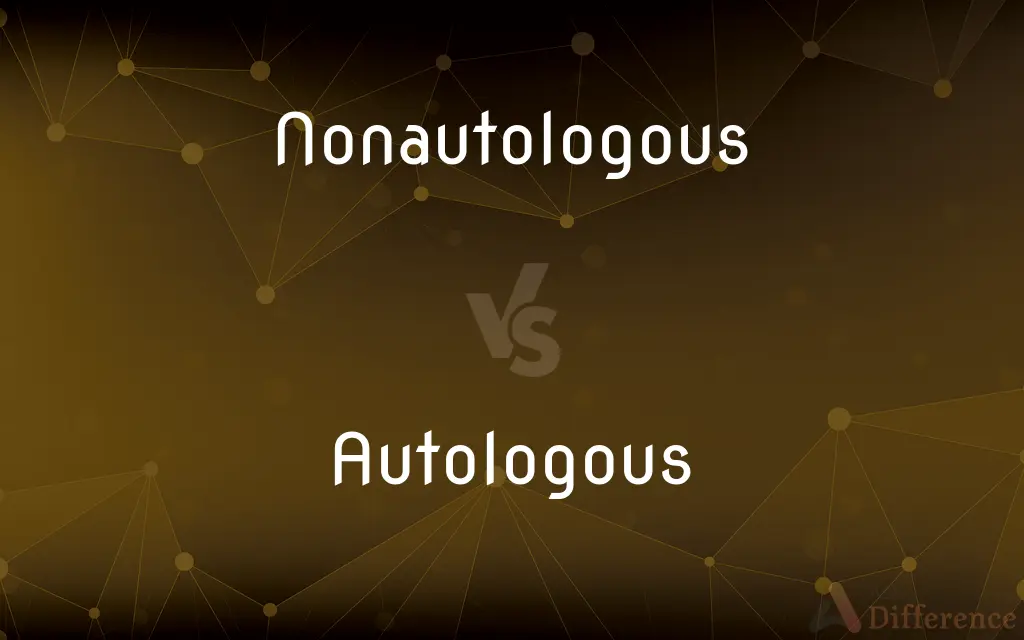Nonautologous vs. Autologous — What's the Difference?
Edited by Tayyaba Rehman — By Urooj Arif — Updated on February 22, 2024
Autologous refers to biological materials originating from the same individual, often used in medical treatments like transplants, while nonautologous involves materials from a different individual or species, used when autologous options are not viable.

Difference Between Nonautologous and Autologous
Table of Contents
ADVERTISEMENT
Key Differences
Autologous treatments involve the use of an individual's own biological materials, such as cells, tissues, for medical procedures. This approach minimizes the risk of immune rejection since the materials are inherently compatible with the patient's body.
Nonautologous, by contrast, pertains to materials that are sourced from a different individual or species. These are employed in situations where autologous options are either unavailable or unsuitable. Nonautologous transplants can lead to a higher risk of immune system rejection, necessitating the use of immunosuppressive drugs to prevent adverse reactions. Examples include organ transplants from donors or the use of animal tissues in certain medical treatments.
The choice between autologous and nonautologous treatments hinges on various factors, including the availability of viable donor materials, the condition being treated, and the potential for immune rejection. Autologous procedures are generally preferred due to their lower risk of complications related to immune response, but nonautologous options provide critical alternatives when self-sourced materials are not an option.
In terms of application, autologous treatments are widely utilized in regenerative medicine, including stem cell therapies and skin grafting for burn victims, where using the patient's own tissues greatly enhances the success and integration of the treatment. Nonautologous methods are essential in traditional transplant medicine, where organs or tissues from donors are the only viable solution for replacing damaged or diseased body parts.
The distinction between autologous and nonautologous treatments underscores a significant aspect of modern medicine's approach to personalized therapy and the challenges of transplant compatibility. While autologous methods offer a streamlined path to recovery with minimal compatibility issues, nonautologous treatments remain indispensable for conditions requiring external donor materials.
ADVERTISEMENT
Comparison Chart
Source of Material
The patient's own body.
A different individual or species.
Risk of Rejection
Minimal, as materials are inherently compatible.
Higher, due to potential immune system incompatibility.
Use Cases
Blood transfusions, bone marrow transplants, skin grafting.
Organ transplants, treatments requiring materials not available from the patient.
Immune Response
Lower likelihood of adverse immune reaction.
May require immunosuppressive drugs to manage rejection.
Application
Regenerative medicine, personalized therapies.
Traditional transplant medicine, when autologous options are not viable.
Compare with Definitions
Nonautologous
Derived from the same individual.
Autologous stem cell transplants use the patient's own cells to treat certain types of cancer.
Autologous
Originates from another individual or species.
Nonautologous organ transplants require donor organs.
Nonautologous
Used in personalized medicine.
Autologous skin grafting involves using the patient's skin for burn healing.
Autologous
Higher risk of immune rejection.
Nonautologous tissue implants necessitate immunosuppression.
Nonautologous
Minimizes immune rejection risk.
Autologous blood donation is preferred to avoid transfusion reactions.
Autologous
Broadens treatment possibilities.
Nonautologous blood products are essential in emergency transfusions.
Nonautologous
Tailored for regenerative treatments.
Autologous cartilage transplantation helps in repairing knee injuries.
Autologous
Involves external donor materials.
Nonautologous stem cells are explored for treatments lacking suitable autologous cells.
Nonautologous
Ideal for immune system compatibility.
Autologous immune cells are modified and used in some cancer therapies.
Autologous
Critical for unavailable autologous options.
Certain severe burn cases rely on nonautologous skin grafts.
Nonautologous
Not autologous.
Autologous
Derived from part of the same individual (i.e. from the recipient rather than a different donor).
Common Curiosities
Why are autologous treatments preferred?
Autologous treatments are preferred due to their lower risk of immune reaction and complications, offering a safer and more compatible option for patients.
How are nonautologous materials sourced?
Nonautologous materials can be sourced from living or deceased donors, or, in some cases, from animal tissues that are compatible with human use.
What are the limitations of autologous treatments?
Limitations include the availability of viable tissues or cells and the patient's overall health, which may impact the ability to harvest or use autologous materials.
Can nonautologous treatments be as effective as autologous ones?
Nonautologous treatments can be effective, especially with proper immunosuppression management, but they generally carry a higher risk of rejection and complications.
Are there ethical concerns with nonautologous treatments?
Yes, ethical concerns include donor consent, allocation of scarce resources, and the use of animal tissues, requiring careful consideration and regulation.
What is the impact of autologous treatments on transplant medicine?
Autologous treatments have significantly impacted transplant medicine by providing alternatives that reduce the need for donor organs and decrease transplant rejection rates.
What does autologous mean in medical terms?
In medical terms, autologous refers to the use of one's own biological materials for treatments or procedures, reducing the risk of immune rejection.
What advancements are being made in autologous therapies?
Advancements include gene editing, tissue engineering, and enhanced stem cell therapies, aiming to improve the effectiveness and application range of autologous treatments.
Can autologous treatments be used for all conditions?
While autologous treatments have a wide application, not all conditions can be treated with autologous materials, especially when a patient lacks healthy tissues or cells.
How does the immune system respond to nonautologous materials?
The immune system may recognize nonautologous materials as foreign, potentially leading to rejection, which is managed through immunosuppressive medications.
What role does compatibility play in nonautologous transplants?
Compatibility is crucial to reduce the risk of rejection and improve the success rate of nonautologous transplants, involving matching donor and recipient immunological profiles.
Is immunosuppression always required for nonautologous transplants?
While not always, most nonautologous transplants require some level of immunosuppression to prevent rejection and ensure the transplant's success.
What are the future prospects for autologous and nonautologous treatments?
The future includes refining techniques to enhance the safety and effectiveness of both treatment types, expanding their use through bioengineering and personalized medicine innovations.
How do autologous treatments benefit personalized medicine?
Autologous treatments are foundational to personalized medicine, allowing for therapies tailored to the individual's specific biological makeup, enhancing effectiveness and minimizing side effects.
How are patients prepared for autologous transplants?
Patients may undergo treatments to harvest their cells or tissues, which are then processed or stored until needed for the transplant procedure.
Share Your Discovery

Previous Comparison
Idea vs. Ideal
Next Comparison
Forementioned vs. AforementionedAuthor Spotlight
Written by
Urooj ArifUrooj is a skilled content writer at Ask Difference, known for her exceptional ability to simplify complex topics into engaging and informative content. With a passion for research and a flair for clear, concise writing, she consistently delivers articles that resonate with our diverse audience.
Edited by
Tayyaba RehmanTayyaba Rehman is a distinguished writer, currently serving as a primary contributor to askdifference.com. As a researcher in semantics and etymology, Tayyaba's passion for the complexity of languages and their distinctions has found a perfect home on the platform. Tayyaba delves into the intricacies of language, distinguishing between commonly confused words and phrases, thereby providing clarity for readers worldwide.
















































